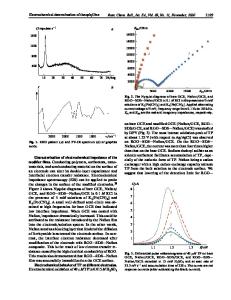Reduced graphene oxide modified activated carbon for improving power generation of air-cathode microbial fuel cells
- PDF / 611,915 Bytes
- 9 Pages / 584.957 x 782.986 pts Page_size
- 3 Downloads / 860 Views
Liu and Hanyu Wang Department of Chemistry and Biochemistry, University of California, Santa Cruz, California 95060, USA
Xun Zhu,a) Dingding Ye, and Qiang Liao Key Laboratory of Low-Grade Energy Utilization Technologies and Systems, Institute of Engineering Thermophysics, Chongqing University, Chongqing 400030, People’s Republic of China
Ke Liu, Shaowei Chen, and Yat Lib) Department of Chemistry and Biochemistry, University of California, Santa Cruz, California 95060, USA (Received 9 June 2017; accepted 29 June 2017)
Activated carbon (AC) has been widely used as catalyst for oxygen reduction reaction (ORR) in air-cathode microbial fuel cells (MFCs). Here we demonstrate a new method to improve the AC air-cathode by blending it with reduced graphene oxide (rGO). rGO sheets are first deposited on Ni foam and AC is then brushed onto it with controlled mass loading. rGO sheets not only improve the electrical conductivity of AC, but also provide a large number of ORR areas. Rotating ring disk electrode measurements reveal that the number of transferred electrons at rGO-AC cathode is 3.5, indicating the four-electron pathway is the dominant process. Significantly, the MFC with rGO-AC cathode delivers a maximum power density of 2.25 6 0.05 W/m2, which is substantially higher than that of plain AC cathode (1.35 6 0.07 W/m2) and those for other air-cathode MFCs using AC as ORR catalyst under the same mass loading.
I. INTRODUCTION
Air-cathode microbial fuel cells (MFCs) can recover wasted energy that is stored in organic matters in wastewater for generation of bioelectricity, and represent a promising solution for energy sustainability.1–6 Yet, noble metal catalysts such as platinum nanoparticles (Pt NPs) and Pt-based metal alloys are typically required to promote the oxygen reduction reaction (ORR) occurred at cathode.7 These noble metal catalysts are expensive and often suffer from time-dependent drift and CO deactivation,8,9 which limit the scalability and practicality of MFCs.10 Enormous efforts have been devoted to develop alternatives to Pt-based catalysts for MFCs.11–13 For example, nonprecious metal NPs, such as metal oxides14 and transition metal macrocyclic compounds15 have been studied for ORR. Khilari et al. reported the use of manganese cobaltite (MnCo2O4) nanorods and Contributing Editor: Teng Zhai Address all correspondence to these authors. a) e-mail: [email protected] b) e-mail: [email protected] DOI: 10.1557/jmr.2017.283
polypyrrole (PPy) as an ORR composite catalyst.16 The MFC equipped with this in situ-synthesized composite achieved a maximum volumetric power density of 6.11 W/m3. Recently, low cost carbon materials, such as activated carbon (AC),17 AC nanofiber,18 carbon nanotube,19,20 and polypyrrole/carbon black composite21 have attracted a lot of attention. Among them, AC-based catalysts are particularly promising because of their outstanding electrochemical stability and cost effectiveness.17,22–25 In a previous study, the AC catalyst showed an excellent catalytic performance for ORR in MFCs, and was e
Data Loading...











